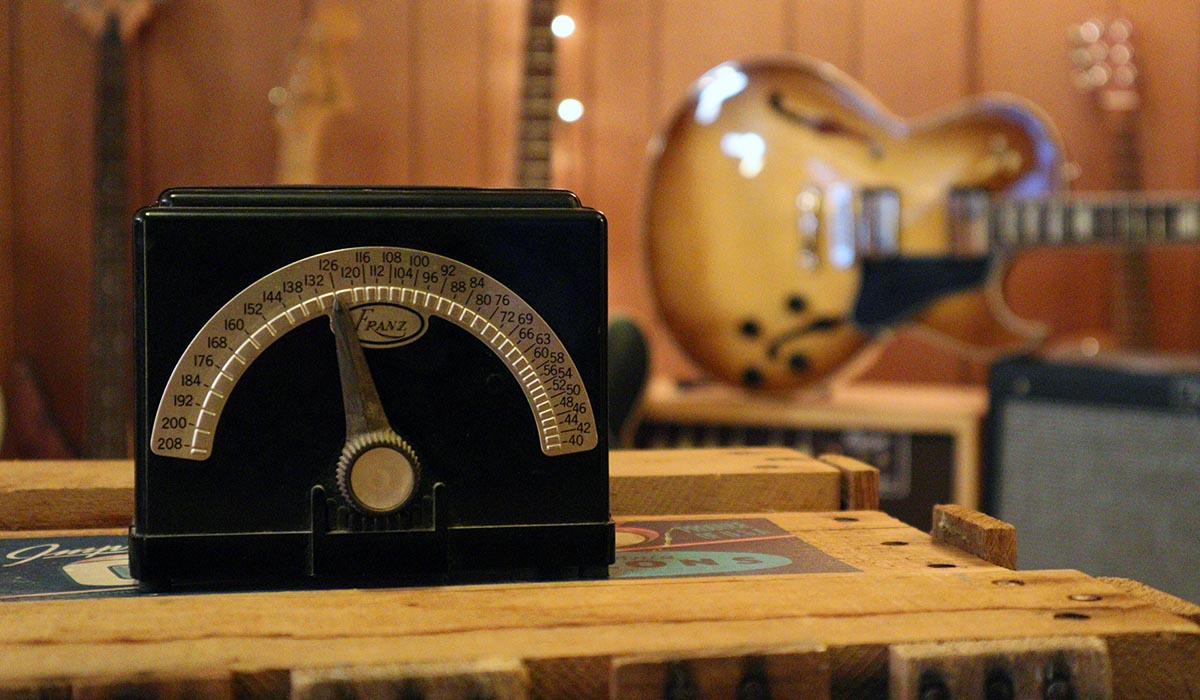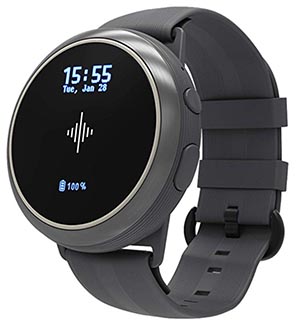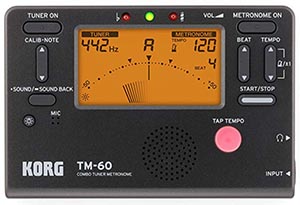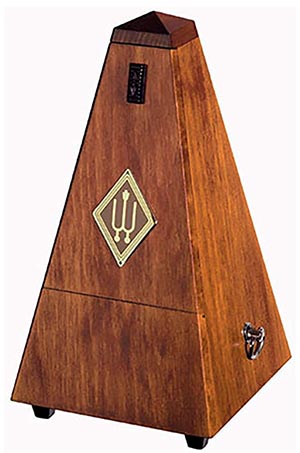Getting a metronome may not be quite as fun as a new fuzz pedal, or a new guitar amp, but they are an important part of learning to play in time. Metronomes range from free on up to about $200 for an all wood mechanical option made in Germany. In this article I’ll arrange, in order, my favorite metronomes and go into detail about which one to get.
The soundbrenner is a revolutionary wearable metronome that changes the way you practice. Music is all about feel right? Well that’s what this metronome allows you to do. Wear it on your wrist, arm, leg, anywhere that provides the best feedback, and the Soundbrenner will keep you on tempo not through an annoying tick tock but through a quick and responsive vibration.
The Korg TM60BK is a tuner and metronome combo that provides a classic metronome tone and visual queue making guitar practice with a metronome incredibly easy. The large screen makes it easy to select the appropriate tempo and time signature, and also makes tuning a breeze. A nice loud tok makes the TM60BK perfect for practice with a guitar or similar instrument. The Korg is a great budget option that gets the job done for most musicians.
Some are looking for the classic looks, feel, and action of a mechanical metronome. It’s also easy to find a large number on Amazon that are made of plastic. This Wittner 804 is a wood body with a mechanical movement and it is all made in Germany. For those seeking a classic metronome that provides a woody tock that brings you back to your childhood piano lessons, the Wittner 804 is the metronome you want to get. I know many people are looking for a wooden metronome like this, and as wooden bodied metronomes are becoming increasingly expensive I found the most affordable of the wooden bodied metronomes that Wittner makes.
Table of Contents
Features to Look For
A metronome is a simple mechanism, however there are some specific things that are important to watch out for that can make one much easier to incorporate into the daily practice routine.
Tap Tempo: Most often, you are selecting a tempo and then playing along to it. However, there are situations where you want to quickly match the tempo of something else, a song you’re practicing for instance, or a tune in your head. Simply tap the ‘tap tempo’ button along with the beat of the song, and the metronome automatically calculates the tempo and starts a beat at that speed.
Most digital metronomes will have this feature, but mechanical ones won’t. You can decide for yourself if this is a feature that you’d like in the metronome you buy. For most players, this is a rare ‘nice to have’ and likely doesn’t constitute a deal breaker.
Downbeat: The downbeat is the first beat of any measure, and is often kicked off by a different sound. For instance, if the beats are ‘tiks’ then the downbeat will be a ‘tok’. This is important for keeping up with a tune and knowing where you’re at in the music. Especially for odd time signatures, a nice downbeat tone is very important.
Almost all digital metronomes (including those suggested in this article) have a downbeat tone, but that isn’t necessarily true for mechanical metronomes. Look for the “bell” option. With a bell means that it will differentiate the downbeat, and ‘without bell’ will not.
Visual Queue: Certain metronomes will have a strong visual queue like a bright flash that can be used to see the beat instead of hear or feel it. These metronomes will often have a silent mode as well that only shows the flashing light. While not super helpful for guitar players, I have seen drummers use these quite a bit as the small ‘tok’ of a metronome can easily get lost in the sound of their drum kit.
Auditory Queue: This is the standard for all metronomes, and while different models will have different tones, almost all will have some sort of auditory click or tok to denote the beats. The exception to this is the Soundbrenner wearable metronome that is built specifically to be felt and not heard.
When looking for a good metronome I like one that has a nice sound. I find some digital metronomes to be grating which make using them less than enjoyable.
Tactile Queue: Some metronomes are designed to give physical feedback, the most obvious being the Soundbrenner which is designed to be worn on the body. In this case you’re looking for something that gives a strong, solid vibration that makes the beat very obvious. As you’re not going to be hearing the beat, the strength of the vibration needs to be strong and short in order to internalize the beat.
Volume: When I’m using a metronome for guitar practice, I generally am playing an acoustic, classical, or electric guitar with the volume turned down quite a bit. In this scenario, I’m not too concerned about the overall volume of the metronome.
However, if you’re playing a bit louder, playing with more than one person, or playing percussion like a drum set, metronome volume is going to be incredibly important. In this case, I would highly recommend the Soundbrenner so that you are feeling the beat and not having to steadily increase the volume of the metronome to compete with the rest of the sound in the room.
Headphone Jack: Most digital metronomes will include a headphone jack that bypasses the little built-in speaker. This can be very handy for not driving your family crazy during your practice time. I find that a small earbud stuck in one ear is a great way to keep the tempo going without drowning out your instrument. This is a pretty specific feature though and one that I wouldn’t consider a deal breaker.
Reliability: As with all guitar and music accessories, we want something that is going to last and not break within a year of use. All of these metronomes on our list are well built and will last for a long time.
Most people who are drawn to mechanical metronomes like the Wittner 804 are looking for something that is focused on design, tradition, and reliability. The Wittner is a great example of a solid metronome that will look and sound great in your music room, or as a fixture on the top of your piano.
Power Source: Power sources for metronomes come in all flavors, replaceable batteries, internal rechargeable batteries, wind up power, and wall outlet power for example. This is often a question of convenience and where you’ll be using the tuner. As a quick note, I’ve never found the digital metronomes that run on AAA batteries to burn through them very quickly. This certainly is a consideration, but power source is pretty low on my list of make or breaks for a metronome.
Convenience: Size, power, and external needs (like a smartphone app) are all important pieces to consider when buying a metronome. Are you going to be traveling a lot with this metronome? Then the Korg or Soundbrenner are the better choices. Is this never going to leave your practice room? Then the door is open for a nice mechanical metronome.
In Depth Reviews
Soundbrenner Core
The Soundbrenner Core is the premium wearable metronome from Soundbrenner. The Core is packed full of features like a tuner, fully integrated DAW support, and decibel meter with customizable alarms, it also features a solid, app driven metronome that will work great for guitar or any other instrument.
The Core is a watch like wearable that can be worn on the wrist, arm, leg, or chest (using the optional extender). Because the Soundbrenner works off of vibrations, it is perfect for any musician playing any type of music. Piano loud enough to drown out a Wittner? Get the Core. Drummer that can’t hear the guitar player over their own playing? Get the Core.
The Soundbrenner does not give off an auditory pulse, but does provide a tactile vibration and a visual flash, both of which can be changed and set to exactly how you want to feel and see it. The vibration is short and strong providing a solid representation of the beat. Soundbrenner claims it is 7x stronger than the vibration of a smartphone, which I do agree with. It gives a great tactile response.
Tap tempo can be set directly on the Core which is easy to set and very useful if you’re someone who uses tap tempo a lot. Changing the tempo is incredibly easy with just a twist of the dial in either direction to speed it up or slow it down.
The real power of the Soundbrenner Core however is in the associated smartphone app that connects to the unit. The Soundbrenner Core can be operated just fine without the app, but the app does open up a ton of great features. For instance time signatures from 1/1 all the way up to 18/8 can be selected and customized. There’s almost no usable time signature that isn’t available on this thing.
Once connected to the app, the Core’s vibration can be customized to intensity and duration, which I found to be incredibly useful for dialing in the best configuration for my style of playing. The light flashes and colors can also be fully customized to give you exactly the response you want.
Another great feature from the Soundbrenner Core is the connectivity to a DAW. The Pulse can connect through MIDI to the clock of the DAW and sync up with your tracks. This is a great feature that can be incredibly useful for quick production, or single person production projects.
Using a metronome can be both difficult and intimidating for a beginner guitar player. The Soundbrenner Core is a great option for a beginner and will give them the tools necessary to begin learning to quite literally feel the beat of the music they’re learning.
The Soundbrenner Core is an awesome metronome that will make using a metronome with your practice easier and more enjoyable. It would also make a great gift for any musician as this is a universal tool that can be used to play any instrument. As a guitar player, I highly recommend the Soundbrenner Core for a guitar metronome.
Korg TM60
The Korg TM60 Tuner / Metronome combo is a great workhorse metronome that I (and many other musicians) grew up using, and still do to this day. It’s easy to use, has all of the features I need, and is one of the most affordable metronomes on the market.
While I typically use clip on tuners for all of my guitar practice, the Korg TM60 has an input which accepts a clip on extension for the best possible tuning. This will work not only for guitar, but for any other instrument as well. It does have an internal microphone to pick up sound that way, but I find the clip on to be much more accurate and allow for tuning in louder settings. This would be particularly helpful for instruments like trumpet or other brass where it may be hard to see the screen of a typical clip on tuner and play at the same time.
The metronome side of the TM60 provides plenty of time signatures and all available tempos making this a great all around metronome that can handle anything the typical guitar player will through at it.
It comes with a headphone jack if you’d rather listen to the tik tok through headphones, and the speaker is strong enough that playing with an acoustic, classical, or electric guitar works great as it provides enough volume to hear easily over those instruments.
Battery life is great on these and typically last about 6 months of heavy use before I have to swap them out. The TM60 also features tap tempo which is great for when I want to determine the exact tempo of a song I’m listening to or trying to learn.
The Korg TM60 is a workhorse metronome and should honestly be in everyone’s practice space, or gig bag. This works great and provides all the essential features most players are looking for in a metronome.
The Korg TM60 is a great metronome for beginners and gives them a chance to start practicing with a metronome without being overwhelmed by fancy tech or too many options. Press the power button, set the tempo, and you’re ready to practice.
Wittner 804
The Wittner mechanical metronome can’t connect to a mobile app, but it does look and sound the best of any other metronome on the market. There’s just something about the warm toc tik tik tik of a mechanical metronome that can’t be replicated by a digital one.
Most people looking for a mechanical metronome like this also want one that is made of wood, the classic ones we all saw at piano lessons growing up. Thankfully Wittner is still making wood metronomes in Germany, and the 804 is the first in the lineup that is fully wood.
The Wittner 804 is powered by a windup mechanism, and then adjusting the weight on the metronome’s arm. Adjusting the weight up will slow the arm’s travel decreasing the tempo, while moving it down speeds it up. The arm is fully marked so you know exactly what tempo you’re at at all times.
The tick is nice and loud making it a great metronome for all instruments, and the visual cue of the arm swinging back and forth make for a perfect option for drummers or whole bands. If you’re looking for a classic mechanical metronome, the Wittner 804 is the best option out there.
The case is made from beautiful hardwood, and looks the best out of all the metronomes I’ve ever used. If this is going to sit in your practice space or on the piano, you can’t go wrong with the handcrafted aesthetics of the Wittner 804.
Other Metronome Options
Metrotimer App: This is a very simple metronome app that gives you all you need with the free version. It has 8 different voicings for the metronome tiks, fully adjustable tempo, tap tempo, and options to use the phone’s flashlight as a visual pulse.
Metrotimer’s free version doesn’t support a downbeat tone, so therefore there are no time signature options. While this is great for keeping general time, it will quickly become useless if you’re working in more complex time signatures.
The one feature about this app that I really like is the quick practice timer which gives you options for 1,2,3,5,10,15,20, and 30 minutes. I love this because I can set a tempo then a quick 10 minutes to work on a specific scale. It’s a great tool for my daily practice routine.
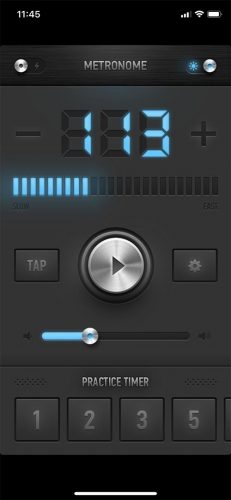
Soundbrenner App: The Soundbrenner app doesn’t require the Soundbrenner Pulse or Core to use it, and the free version is also the full version of the app. The Soundbrenner metronome app has a very pleasant tik sound with fully customizable time signatures and subdivisions which are great for working on more complex material.
It features tap tempo and the option to customize the feedback for each beat, something I haven’t seen on most other metronomes or metronome apps. The one downside is that it is basically a tool to sell their products so it includes ads for the Core when you start up the app. I get it, it’s a free tool and I can live with that, but it is slightly annoying.
The other downside is a lack of timer. As a practice tool I find that the Metrotimer app is a bit better for handling all of my practice needs.
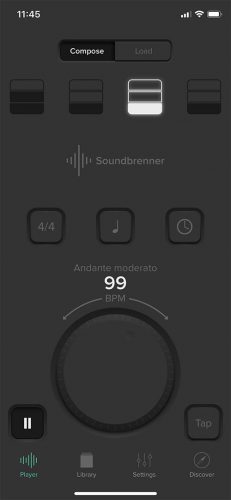
DAW Metronome: Many guitar players are getting into home recording and therefore have access to a metronome of some sort through the DAW that they use. I use both Pro Tools and Ableton and have used both of those metronomes not only for recording but for practice as well.
As long as you’re sitting next to your computer and don’t mind listening to the metronome through headphones or your monitors it might work just great for you. I find that pulling up a new project just so i don’t mess with the tempo of a working session to be a bit of a bother, but it certainly is one of the cheaper options available.
Garage Sale Finds: This might be my favorite option. I found an old Franz LM-4 electric metronome at a garage sale for a whopping $5. It has a great tik that is loud enough for me to play drums along with, and an easy tempo selection that goes from 40 BPM to 208 BPM.
Of course you’ve got to give these old things a lot of grace especially as this one has drifted a bit and is now about 7 BPM off from where it should be. This isn’t a deal breaker because this is such a cool old metronome. It fits the vibe of the lounge quite well, and for those that have a specific music space, I know you know what I mean.
Common Questions about Metronome for Guitar Players
Is a metronome necessary?
A metronome isn’t completely necessary, but it is an incredible tool for teaching time and getting a musician comfortable with playing to a click. You’ll find a lot of people on the internet suggesting that a metronome is a waste of time or even detrimental to beginning players. I don’t agree with this. Time is a fundamental part of music and consistent tempo isn’t something that is innate in every player. This is a skill that needs to be developed and practiced.
You may not notice your lack of tempo control when playing alone, but get in front of an audience or join a band and it will become very clear that your tempo needs work if you’ve never played to a metronome before.
A lot of players will claim that their playing is expressive and not meant to keep perfect time. And while there is some value and truth to that, these players saying that are typically the ones that can’t hold a constant BPM. First learn how to keep time correctly. Then you’ll have the skills and license to brand out and use time for expression.
What should you practice with a metronome?
When first starting out with a metronome, simply play a song that you already know but play along with the metronome. See if you can play the whole thing through with the click of the metronome behind you. This can be incredibly difficult at first and very frustrating. Stay calm and keep working on it. Soon, you’ll be playing along in time no problem.
After this, I like to work on scales, patterns, licks, or chord progressions to a metronome. First I’ll work out the actual notes and fingerings, then I’ll play along with the metronome. Start slow, and depending on the difficulty of what you’re playing, this may be in the 50 or 60 bpm range. Slowly increase the tempo as you get better at playing the passage.
Check out this video on playing guitar with a metronome from Justin Guitar. He does a great job of laying out the basics on how to get started.
I’m having a hard time playing with a metronome. Any Tips?
Playing with a metronome at first can be incredibly difficult. Stay calm and be patient. If you stick with it, the skill will come in no time.
- Relax: Don’t stress too much. This is a difficult skill so don’t be too hard on yourself. Also, the more tense you are the harder it will be to play in time. Take some deep breaths, and relax your body.
- Turn it up: It’s important that your metronome is loud enough for you to hear it over the volume of your guitar. Sometimes I like to put a single earbud in my left ear and plug that into the metronome. This gives me a solid click that i can clearly hear over my guitar, and an added bonus is it doesn’t drive anyone else crazy.
- Start Slowly: Don’t play too fast right out of the gate. In fact, a lot of music is much harder when you slow it way down. This forces you to really execute the passage perfectly and hear all the intricacies of the sound. Slowing things down helps develop a sense of time as well, as time can be harder to feel the slower it gets.
What is a click track?
A click track is simply a track or DAW feature that functions as a metronome in the recording environment. These days there are metronomes built right into the DAW which are incredibly helpful for recording. These are typically loaded up and played for the musicians if the drums are not tracked yet.
